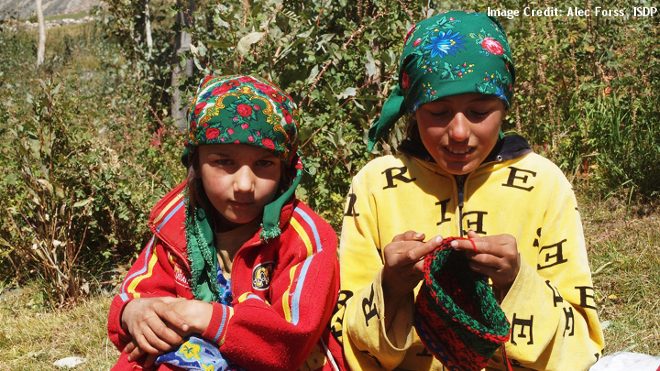Losing Out: Barriers to Girls’ Education in Tajikistan

Barriers of poverty and a revival of conservative social norms in Tajikistan mean that girls are increasingly losing out in access to education, explain Zarinam Turdieva and Maria Hellborg.
The quality of education in Tajikistan has been in decline since independence and the country’s ensuing civil war (1992-1997), which saw an estimated one-fifth of schools destroyed. Amidst “severely inadequate” funding for education, the situation has been further exacerbated by a brain drain with many educated people, including qualified teachers, having left the country in order to escape economic hardships.
The latest United Nations Education Index (a joint measure of mean years of schooling and expected years of schooling) ranks Tajikistan 133 out of 187 countries – the lowest rank of all former Soviet republics.
A particular concern is a growing gender divide between boys and girls in access to education. Despite compulsory primary and secondary education in Tajikistan, children from poor families, especially girls, frequently drop out before completing the currently required nine years of schooling.
According to UNESCO statistics, differences start appearing in the fifth grade (at age 11) when almost 10 percent of girls are absent from school compared to around 2 percent of boys. While not compulsory, this difference is magnified in upper secondary school (from age 16) with 48 percent of girls – compared to 30 percent of boys – not attending.
What then are the driving factors behind this educational gender divide?
Barriers for Girls
After independence, Tajikistan witnessed growing tensions between differing ideas about how the new state should be formed. A revival of more conservative cultural norms and religious values have given rise to more traditional conceptions concerning gender roles in Tajik society – with negative consequences for girls’ education.
Rather than attend classes, young women are expected to take care of the household, raise children, and care for older relatives. Predominantly male labor migration to Russia, among other countries, has also worsened the situation for women left behind, who are forced to provide for their families alone with older daughters helping their mothers with work while younger daughters take care of their even younger siblings.
Poverty also reduces educational opportunities for girls. While primary and secondary education is free according to Article 41 of the Tajik constitution, low teacher salaries and a lack of financial resources has given rise to parents having to give bribes to teachers to register their children in school. A decree issued by the Ministry of Education in August 2013 that obliges pupils to wear (and pay for) school uniforms is an additional financial constraint for poor families.
These problems are compounded for households in remote, mountainous areas where travelling to and from school is prohibitively expensive.
The upshot of these constraints is that parents typically choose to prioritize their sons’ education instead of their daughters. Indeed, as girls and young women are considered “only” temporary members of the family – going to live with their husbands’ families upon marriage – parental incentives to invest in their daughters’ education are reduced.
A further impediment is that of child labor affecting both boys and girls. While prohibited under Tajik labour laws, data from the International Labor Organization (ILO) shows that 23.4 per cent of all Tajik children between the ages of 5-17 were involved in child labor between 2012-2013. However, the ILO’s national coordinator for eradicating child labor suggests that more than 60 percent of all children are working in the cotton industry at least a quarter of each year, especially during harvesting period which is very labor-intensive.
Promoting Gender Inclusive Education
The Tajik constitution states that all men and women are equal. Tajikistan is also a signatory to relevant international conventions concerning girls’ education, including the Convention on the Elimination of All Forms of Discrimination against Women and the Convention on the Rights of the Child.
Notably, in 2012 the government adopted the second National Strategy of Education Development of the Republic of Tajikistan till 2020. According to the strategy, a key intention is to expand access for both genders to secondary and higher education, paying special attention to the involvement of girls in education. Specific goals identified are promoting the level of education of girls as well as developing programs of vocational training beyond compulsory education.
In spite of such pledges, barriers of poverty and social norms identified above mean that girls are continuing to lose out. This could have serious implications for Tajikistan’s ability to secure its commitment to the fourth goal of the Sustainable Development Goals, which aims to ensure that all girls and boys complete free, equitable, and quality primary and secondary education by 2030.
More efforts need to be undertaken, both by the Tajik state and international organizations, to raise awareness of the importance of gender quality in education, for instance through information campaigns targeted at communities and families. This also needs to be accompanied by tangible measures that allow girls to access equal educational opportunities.
Failure to do so will otherwise bode ill for both Tajik girls and women, as well as Tajikistan’s future.
Dr. Zarinam Turdieva holds a PhD from the Kyrgyz-Russian Slavic University in Kyrgyzstan. Maria Hellborg holds an MA in International Law from Uppsala University.